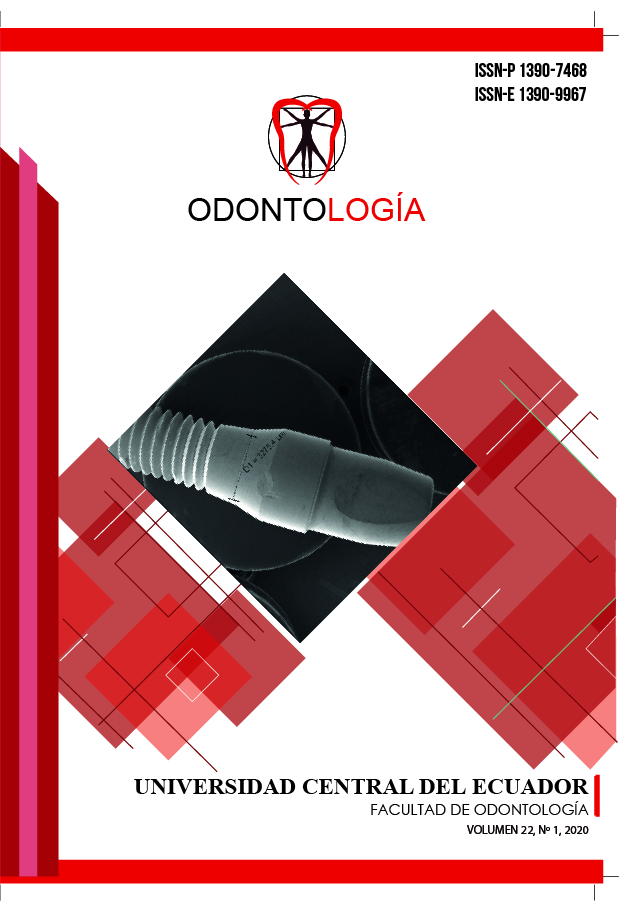Clinical and epidemiological characteristics of non-carious cervical injuries
DOI:
https://doi.org/10.29166/odontologia.vol22.n1.2020-36-54Keywords:
Etiology, toth erosion, risk factors, abrasion, toth diseases, bruxismAbstract
Non-carious cervical lesions result from the loss of tooth structure in the cervical region of the vestibular surface of the dental elements, not related to caries. With the objective to verify the clinical and epidemiological features and risk factors of these injuries were evaluated 300 dental elements on 96 adult patients that were subjected to interview and intraoral clinical examination. The results presented a prevalence ratio in which the 0,87 of patients evaluated are prosthetic users. In oral hygiene habits, 0,51 use soft brush, 0,52 brush three times a day and 0,68 use brushing direction combined. Was evaluated in these patients that 0,56 have a history of gastrointestinal pathologies; 40% made use of medications and 0,36 have disocclusion characteristics in canine guide. In relation to the characteristics of the lesion, 0,40 have type of contact, 43% with a depth less than 1 mm and 0,13 are retainers of removable partial denture. As for the eating habits, 0,93 consume citrus fruits and 0,15 are smokers. Regarding parafunctional habits, 0,35 clench your teeth; 0,36 have bruxism and 0,10 bite objects. These lesions showed a higher prevalence in premolars 0,54.Verified the clinical and epidemiological features and risk factors of non-carious cervical lesions, we conclude that the determining factor for the emergence of these lesions has shown characteristics multifactorial, with highest percentage for patients with occlusal instability, intake of acidic drinks, prosthesis, gastrointestinal diseases and parafunctional habits.
Downloads
References
Baratieri LN, et al. Odontologia Restauradora: Fundamentos e Técnicas. Gen Grupo Editorial Nacional. Ed Santos SP 2010; p 760.
Perez CR, Gonzalez MR, Prado NAS, Miranda MSF, Macedo MA, Fernandes BMP. Restoration of noncarious cervical lesions: when, why, and how. Inter J Prosth Dent 2012; 8 (10); 2-8.
Boric J, Anic I, Urek MM, Ferreri ES, The prevalence of non-carious cervical lesions in permanent dentition. J oral rehabil 2004; 117 – 123.
Oliveira ACS, Damascena NP, Souza CS. Análise clínica de pacientes portadores de lesões cervicais não cariosas e sua relação com hábitos. Rev Sul-Bras Odontol 2010 Jun; 7(2):182-92.
Lima LM, Humerez Filho H, Lopes MGK. Contribuição ao estudo de prevalência, do diagnóstico diferencial e de fatores etiológicos das lesões cervicais não-cariosas. RSBO. Sul-Bras Odont 2005; 2 (2); 17-21.
Barbosa RPS, Santos RL, Gusmão ES. Terapias para controle de lesões não cariosas hipersensíveis. Odont Clín Científ set/dez 2005; 4 (3): 171-176.
Nguyen C, Ranjitkar S, Kaidonis JA, Townsend GC. A qualitative assessment of non--carious cervical lesions in extracted human teeth. Aust Dent J 2008 Mar;53(1):46-51.
Grippo JO, Simring M, Schreiner S. Attrition, abrasion, corrosion and abfraction revisited: a new perspective on tooth surface lesions. J Am Dent Assoc 2004 Aug;135(8):1109-18; quiz 1163-5.
Litonjua LA, , Andreana S, Bush PJ, Cohen RE. Tooth wear: attrition, erosion and abrasion. Quintessence Int 2003; 34; 435-446.
Brandini DA, Lunardeli CT, Panzarini SR, Pedrini D. Clinical evaluation of the association between noncarious cervical lesions and occlusal forces. Rev J Prosth Dent 2012 November; 108: 299-303.
Heasman PA, Holliday R, Bryant A, Preshaw PM. Evidence for the occurrence of gingival recession and non-carious cervical lesions as a consequence of traumatic toothbrushing. J Clin Periodontol 2015; 42 (16): 237–255.
Lordanishvilia AK, Chernyjb DA, Yankovskijb VV, Orlovc AK, Drobkovac KO. prevalence of noncarious hard dental tissue lesions in adults at various age periods. Adv in Geront 2015; 5 (4): 298–302.
Poiate IA, Vasconcellos AB, Poiate E Jr, Dias KHC, Stress distribution in the cervical region of an upper central incisor in a 3D finite. Braz Oral Res 2009; 23(2): 161-7.
Romeed SA, Malik R, Dunne SM. Stress analysis of occlusal forces in canine teeth and their role in the development of non-carious cervical lesions: abfraction. Inter J Prosth Dent 2012; Artic ID 234845, p 7.
Sawlani K, Lawson NC, Burgess JO, Lemons JE, Kinderknecht KE, Givan DA. Factors influencing the progression of noncarious cervical lesions: A 5-year prospective clinical evaluation. Rev J Prosth Dent 2015; 1-7.
Smith BG, Knight JK. Na index for measuring the wear of teeth. Br Dent J. 1984 jun 23; 156(12):435-8.
Michael JA, Townsend GC, Greenwood LF, Kaidonis JÁ. Abfraction: separating fact from fiction. J Aust Dent 2009; 54: 2–8.
Jakupovic S, Cerjakovic E, Topcic A, Ajanovic M, Konjhodzic PA, Vukovic A. Analysis of the abfraction lesions formation mechanism by the finite element method. ACTA Inform Med 2014 Aug; 22(4): 241-245
Telles D, Pegoraro LF, Pereira JC. Prevalence of noncarious cervical lesions and their relation to occlusal aspects: a clinical study. J Esthet Dent 2000; 12(1):10-5.
Luthi LF, Santos MBF, Henriques GEP, Barbosa CMR. Odontogeriatria e as Lesões não Cariosas. UNOPAR Cient Ciênc Biol Saúde 2010;12(4):37-40.
Vasudeva G, Bogra P. The effect of occlusal restoration and loading on the development of abfraction lesions: A finite element study. J ConservDent. 2008 Jul;11(3):117-20
Published
How to Cite
Issue
Section
License
Copyright (c) 2020 Jorge de Sá Barbosa, Maria Julianne de Sousa Silva, David Montero, Henrique Tuzzolo Neto, Rodrigo Alves Ribeiro, Claudio Costa

This work is licensed under a Creative Commons Attribution-NonCommercial-NoDerivatives 4.0 International License.


